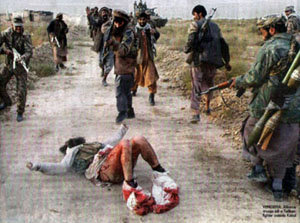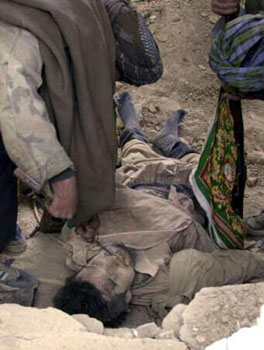UN team finds evidence of summary execution, suffocation in mass graves
Associated Press, 7 May, 2002
By NIKO PRICE
KABUL, Afghanistan (AP): A U.N. forensic team examining a large mass grave in northern Afghanistan found evidence some victims died of suffocation, the United Nations said Tuesday. The grave site is the same one made public last week by the U.S.-based Physicians for Human Rights which said the grave was believed to hold the bodies of hundreds of Taliban prisoners who died while captives of their northern alliance foes last fall. Northern alliance forces were U.S. allies in the war that defeated the Taliban religious militia. The interim Afghan regime is now made up of many members of the alliance.
The U.N. team also examined two smaller, apparently older sites and found evidence of summary executions, said U.N. spokesman Manoel de Almeida e Silva. All of those victims, he said, appeared to be men of Hazara ethnic origin, whom Afghanistan's former Taliban rulers were accused of slaughtering in the late 1990s.
At the biggest grave, bodies had been buried with heavy machinery over a large area of desert in Shibergan, just west of the city of Mazar-e-Sharif.
More Photos
The absence of blunt-force trauma, sharp-force injury or firearm injury led the team to conclude that the cause of death was consistent with death by suffocation,'' Almeida said.
The physicians group reported witnesses told it northern alliance soldiers, their noses and mouths covered against the stench, dumped entire railway containers into the area in late December and early January. Such poorly ventilated containers have been used as makeshift prisons throughout the country.
The physicians group appealed to the United Nations and the Afghan interim government in Kabul to cordon off the area until it could be investigated, the numbers of bodies determined and their identities learned. The top U.N. human rights official, Mary Robinson, ``picked up on (the appeal) and asked for some of our people to consult with them,'' Susannah Sirkin, deputy director of Physicians for Human Rights, said by phone from the group's Boston headquarters. She confirmed the site her group reported on and the one the U.N. team investigated were the same.
The team that visited the sites this week consisted of two experts from the physicians group and one person from the U.N. human rights agency, according to Almeida. Sirkin said her group was ``very pleased'' that the United Nations was beginning to examine ``not only these graves but others as well. ... We had only done a first look-see and could not do anything further as a private organization, especially given the security situation in the country.'' While just a ``first step, we hope that the attention to these graves now will provide an impetus for a more thorough examination of things that occurred in earlier years as well as recent months,'' she said.
Northern Afghanistan has one of the worst histories of mass killings on all sides of the fighting during 23 years of Soviet occupation and the subsequent civil war. The United Nations investigated a report of as many as 2,000 Taliban massacred around Mazar-e-Sharif in 1997, finding evidence of mass graves. A year later, the Taliban were accused of slaughtering ethnic Hazaras in revenge when the religious militia retook the city.
Almeida said the team had not determined how many bodies were in the Shibergan grave, but in a small test area revealed 15 sets of remains at a depth of 5 feet. The team exhumed three bodies for autopsy, and they appeared to be Pashtun, the predominant ethnicity in southern Afghanistan, he said. Most of the Taliban were Pashtun. Almeida said all those which underwent autopsies died after last fall as the northern alliance drove the Taliban from power.
``It's very disturbing to see initial evidence that some of these prisoners died of suffocation,'' Sirkin said. At another, apparently unrelated site, the team uncovered 18 bodies from a shallow grave in the town of Daouti in Bamiyan province and had autopsies performed on three, Almeida said.
``The indications are that all died of gunshot wounds, mostly to the head and back,'' he said. ``One body was found with its hands bound, indicating summary execution.'' The victims at Daouti apparently died between last fall and three years ago. All appeared to be men of Hazara ethnic origin, who ranged in age from teen-age to the elderly, Almeida said. At the third site _ the airport in Mazar-e-Sharif _ bodies had been lying on the surface or in shallow graves, but in the last three months were dumped into a trench, complicating the forensic work, Almeida said. It was unclear how many bodies were examined there.
Northern alliance fighters try to pull out a golden tooth from the body of a pro-Taliban fighter in a fortress near Mazar-e-Sharif, Nov 28, 2001. AP Photo
The U.N. team was preparing a list of other possible mass-grave sites, and studying Afghanistan's capacity to investigate them, Almeida said.
``We anticipate that as a result of more access ... it is possible that we will have more indications of grave sites being discovered,'' Almeida said. ``The experts will make recommendations on how to proceed with this possible added demand.''
Crimes of the "Northern Alliance" Seen Through the Eyes of a Grieving Mother US Bombs Wipe Out Farming Village What will the Northern Alliance do in our name now? I dread to think... No surprise at rumours of new atrocities by our 'foot-soldiers' Many Afghans haunted by Northern Alliance's past Fall of Kabul Could Lead to a Bloodbath, Officials Warn Hundreds of Pakistanis believed massacred UN Reports Mazar-e-Sharif Executions Kabul residents fear northern alliance, worry for their safety Kabul

